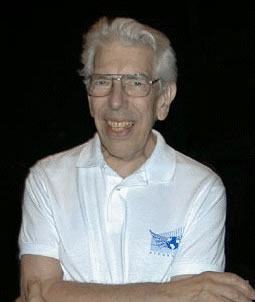 |
Bob
Trousdale and His Works Mr. Trousdale certainly has much to smile about!! |
 |
Bob
Trousdale and His Works Mr. Trousdale certainly has much to smile about!! |
|
|
|
On the left side of the console in this view can be seen three card cages, one above the other, which contain the circuit cards needed to control various aspects of the organ. Although the pipes in the organ are wind blown, it is necessary to provide an electromagnet for each pipe which serves to turn the pipe on and off through a series of pneumatic valves. The magnets are driven in today’s organs by electronic circuits whereas at the time the organ was built, they were driven by large banks of pneumatic relays and switches, located in a large “relay room”. The “relay”, as it is still called, is made up of the electronics in the upper card cage inside the console, in conjunction with more electronics located in the old “relay room” in the basement. The two are interconnected by a small cable containing only a few pairs of wires; the signals being sent at very high speed. Through “multiplexing”, the few pairs of wires contain all the information needed to control over 2,600 pipe magnets. The console part of the relay handles all of the logic necessary to interconnect all of the playing keys and all of the stopkeys. When a stopkey is depressed, it closes a circuit which connects one of the 61-note keyboards to one of the ranks of pipes. Some ranks consist of 61 notes, but most have extra octaves on the top or the bottom, and other stopkeys make it possible to play these octaves through “octave coupling” or “unification”. Special circuits in the relay provide features such as pitch transposition, pizzicato coupling, sostenuto and the capability to drive synthesizers through a MIDI interface in the relay room. Triggering of the percussion sounds - the drums, cymbals, tambourine, wood block, and tuned percussions such as piano, vibraharp, chimes, xylophone, glockenspiel and the like are also handled in the relay. |
Player System Going back to the console card cages, the section in the center (below the relay) contains the circuits necessary to interface the relay with a PC computer; located on the right side. Together, these circuits and the computer form the organ “player” system. In use, every key depression, stop key and swell pedal position is recorded in a computer file which can be saved and later played back. Thus the organ can be made to reproduce songs previously recorded; much like a player piano. The software in the computer has many editing features so that recordings can be “cleaned up” if needed. Notes can be added or deleted; their timing can be modified, and stops can be changed through this program. Bob Trousdale spent years developing this program and it can be found in many organs around the country. One of its uses is in providing archival recordings of organ concerts. It greatest use is in preparing the songs to be performed when making the acoustic recording of the organ for a compact disk release. |
The lower section of the console card cage assembly is called the “combination’ action.
In order to make quick selections of stops while playing the organ, many “pistons” are
provided for each of the keyboards. These are simply controlling
push buttons, located on the narrow strips under each keyboard. The combination action electronics contains a 32,000 byte memory chip, and the function of each piston can be stored ahead of time by the organist, utilizing a “setter” button which causes the stops manually selected to be written into the memory. Each stopkey contains two electromagnets, one to turn it on and one to turn it off. Hence there are a great many magnet drivers required, and the bulk of the combination action is taken up with these circuits. Each organist that comes to play a concert has his own selection of piston combinations. In order to save his settings for later recall, the combination action includes a small cassette recorder that can be used to create a unique tape holding all of his piston settings. Basically what happens is simply a tape dump of the contents of the 32,000 byte memory chip. The console contains boxes of these tapes, each labeled with the organist’s name. When the Plummer organ was delivered in 1929, electronic circuits were not available, so the combination action was built using hundreds of pneumatic relays and switches (similar to the original “relay”) and occupied a whole room just offstage. The memory consisted of bank after bank of unique memory magnet assemblies, each consisting of an “off” coil and an “on” coil, together with an armature that would remain tilted one way or the other; closing a circuit in the process. These coils would be energized whenever the “setter” button was pushed on the console. It would have taken 256,000 of these assemblies to duplicate the present capacity of the Plummer organ electronic memory chip. Needless to say, the original combination action had only a tiny fraction of that much memory. The present 32,000 byte memory chip, of course, pales in comparison with chips readily available today with gigantic capacities in the millions of bytes. |